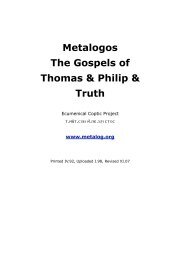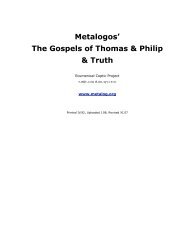Andrew Louth - Syriac Christian Church
Andrew Louth - Syriac Christian Church
Andrew Louth - Syriac Christian Church
You also want an ePaper? Increase the reach of your titles
YUMPU automatically turns print PDFs into web optimized ePapers that Google loves.
NOTES 215<br />
3 The ‘earth of the heart’ is imagery stemming ultimately from the<br />
Macarian Homilies: see, e.g., Collection I.3.3.8–9 (Berthold [1973], 31–<br />
2).<br />
4 Cf. Luke 12:49.<br />
5 In Opusc. 3 (below), this reference to the coldness of the Monophysite<br />
and Monothelite heresies appears to be derived from the name Severus<br />
and the region of the north which seems to be associated with that name<br />
(the region of the north is surely alluded to here as well). Could Maximus<br />
possibly be deriving Severus’ name from the Slavonic word for the<br />
north, sever? It is quite unclear how Maximus might have known this,<br />
but during his days as protoasecretis he must have had some knowledge<br />
of the Slav tribes that by then had been settling south of the Danube in<br />
the Sklaviniae for some decades.<br />
6 Perhaps an allusion to James 2:8.<br />
7 An allusion to two of the ‘Chalcedonian’ adverbs.<br />
8 Although this passage has clear allusions to the Chalcedonian<br />
Definition, there seem to be even clearer allusions to the language of<br />
both the Alexandrian Pact of Union and the Ecthesis itself.<br />
9 Here, not Theotokos but Theomêtêr.<br />
10 The Chalcedonian Definition asserted that Christ is known ‘in two<br />
natures’. The original draft had ‘out of two natures’, and this is<br />
preserved in most of the Greek manuscripts. Maximus characteristically<br />
combines them, and often adds a straight assertion of identity (‘from<br />
which and in which and which he is): see Piret (1983), 203–39.<br />
11 The Monophysites conceded that in Christ two natures came together,<br />
but that after the union they became a single composite nature, and so<br />
were no longer two.<br />
12 The Fathers universally held that the idea that Christ’s humanity preexisted<br />
and descended with the Word in the Incarnation was a corollary<br />
of Apollinarianism, though it seems clear that Apollinaris intended no<br />
such thing (see Grillmeier [1975], 330–3). Maximus repeats the calumny<br />
against his Monophysite and Monothelite opponents, with probably as<br />
little justification.<br />
13 Maximus probably has in mind Rom. 11:16.<br />
14 For the Ecthesis, see the introduction.<br />
15 Quoted by Sophronius: Synodical Letter (PG 87:3173B). It has not been<br />
found in Gregory of Nyssa’s extant works.<br />
16 Much closer to Luke 22:42 than the other Gospels, but not exact.<br />
17 Cyril, Commentary on St John’s Gospel, book 10, on John 14:21 (Pusey<br />
[1872], II. 493), cited in session 10 of the sixth Ecumenical Council<br />
(Riedinger [1990], 326).<br />
18 Athanasius, On the Incarnation and against the Arians 21. Some doubt<br />
has been expressed as to whether this treatise is genuine, but it still has<br />
its defenders. It was cited at the 10th session of the sixth Ecumenical<br />
Council (Riedinger [1990], 298).<br />
19 Athanasius here conflates the words of Jesus’ prayer to the Father<br />
(Matt. 26:39) with his words to the sleeping disciples (Matt. 26:41).




